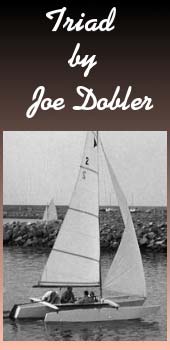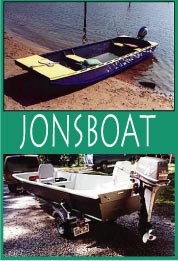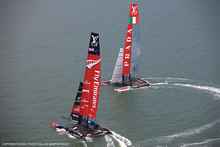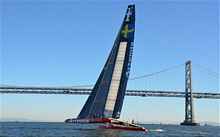
 Custom Search
|
| boat plans |
| canoe/kayak |
| electrical |
| epoxy/supplies |
| fasteners |
| gear |
| gift certificates |
| hardware |
| hatches/deckplates |
| media |
| paint/varnish |
| rope/line |
| rowing/sculling |
| sailmaking |
| sails |
| tools |
| join |
| home |
| indexes |
| classifieds |
| calendar |
| archives |
| about |
| links |
| Join Duckworks Get free newsletter CLICK HERE |
|
|
| Out There |
by Paul Austin - Dallas, Texas - USA Brouhaha |
 |
A friend of mine, who knows me better than a proctologist, asked me about the America's Cup brouhaha. Where'd that word come from? Was it one of the three witches in MacBeth, over the cauldron swirling her broom in the swill saying, "A brew, Ha Ha!" Well, it came from the French, which reminds me that Mark Twain once said: "God made man a little lower than the angels and well above the French". I mention such insulting sarcasm because brouhaha was used by the French to imitate the sound the devil would make when he arrived on stage in a play. I'd just as soon hit him with a pie in the face. In any event, you can always count on the yacht club crowd to ruin a race. They've gone so far as to make the America's Cup half sailboat-half hang-glider race.
The Plastic Cup (I can't call it the America's Cup anymore) is being sailed in San Francisco Bay, this September 7-25. The American boat-glider defending is owned by the Golden Gate Yacht Club against the challenge of the Kungliga Svenska Segelsallskapet, the Swedish challenger. Don't ask me how to pronounce that, I think it means Kung Fu on the Carpet, or something like that. The Cup will be 17 races, so you have time to work on your Swedish meatballs. To drum up interest, there were races in 2011, 2012 and 2013. The winner of each of these races gets to declare themselves the America's Cup World Series Champion for that season. I'm declaring myself Cup World Series Champion For This Week, even though I don't have a boat, since they don't use real boats any more, anyway. By the way, each of these sail-gliders costs $100 million - why not just glue two San Francisco Pelicans together with a tarp sail and get on with the racing?
But the real brouhaha is about the safety of these damned sail-gliders. To get to 40 knots, very little boat is in the water. Sir Keith Mills cancelled his British Team Origin campaign in 2011 over safety. These boats are designated, AC72; one of them pitch-poled in October 2012 after only 8 days of sailing in San Francisco Bay. The boat, damaged into pieces, was drawn out of the bay by tides on into the Pacific. But the human element in this brouhaha was the tragedy of Andrew Simpson, Olympic medalist on the Swedish team Artemis' first AC72. Andrew Simpson was a veteran sailor, British Olympic champion and quite popular with the racing crowd. He was known as someone with more talent and less ego than practically anyone else. His nickname was 'Bart.' His boat was simply practicing in light winds near the shore. He was caught underneath the boat when it pitched, ending a young life. Everyone knew these 40 knot boat-gliders are dangerous. The crew wears helmets and crash gear with air bottles, in case they have to jump ship. They carry knives, if they have to cut away lines tangled underwater. Rescue ships follow, but with these AC72s, everything collapses so fast, a popular human life was lost. After Simpson's death, crewmen on other boats said in interviews the yachts are 'overpowered.' Max Sirena, skipper of the challenger Luna Rossa, said, 'When Oracle crashed, I said that will not be the only one, this will happen again. And now it's happened again. These are dangerous boats. The boat is basically too powerful. At the same time, this is our sport. This is a risk we take.' In one of Simpson's last Twitters, he said, "Seeing what those boats were capable of, speeds of up to 40 knots, frightened the life out of me. The class rules looked like they were dangerouns boats to sail. At 40 knots, the control is minimal. Hit a big wave and that is it." How did we get here? In 2007 the America's Cup boats were built of one hull. The winner gets to dictate the technology of their defense, so the most recent winner of the Cup, Larry Ellison (fifth wealthiest man in the world), decided on multihulls 70 feet long. In 2007 the top monohull speed was 15 knots; now the AC72s make over 40 knots. Ellison is reported to be concerned only with growing the sport with the young to make it sport for the superrich. He wants to make it dangerous enough for a lethal combination of the young and the extremely wealthy. The concept is the 15 and 17 year olds will love the speed, only Ellison's wealthy cronies will be able to afford to build an AC72. That will shove the older generation of yachtsmen and clubs and designers out of the Cup. So, for the preliminary races in San Francisco - designed to attract a new generation - only three syndicates could afford a $100 million cost for a boat. But will that spread the appeal of the sport? Evidently not, and maybe Ellison doesn't want the sport to grow, merely become the vogue among his million dollar cronies. However, these AC72s just barely touch water. This does not allow them to race against another boat. They touch down, fly up and touch down again. No real tactics. And no loyalty in crew. On the Swedish boat that competed a few years ago, none of the crew were Swedish. Everyone is a professional racing sailor, nearly always from Olympic competition, but loyal only to salary. And these sail-gliders are dangerous. What Ellison and the syndicates seemed to have ignored is the wide public who sail boats. I wouldn't be writing this for Duckworks were it not for the revival in wood boats triggered by Dynamite Payson and others. But we aren't the yacht club crowd, we aren't the syndicates. We have our own races. I hope no one gets hurt in September. Paul is also publishing his books on Amazon. |
|






